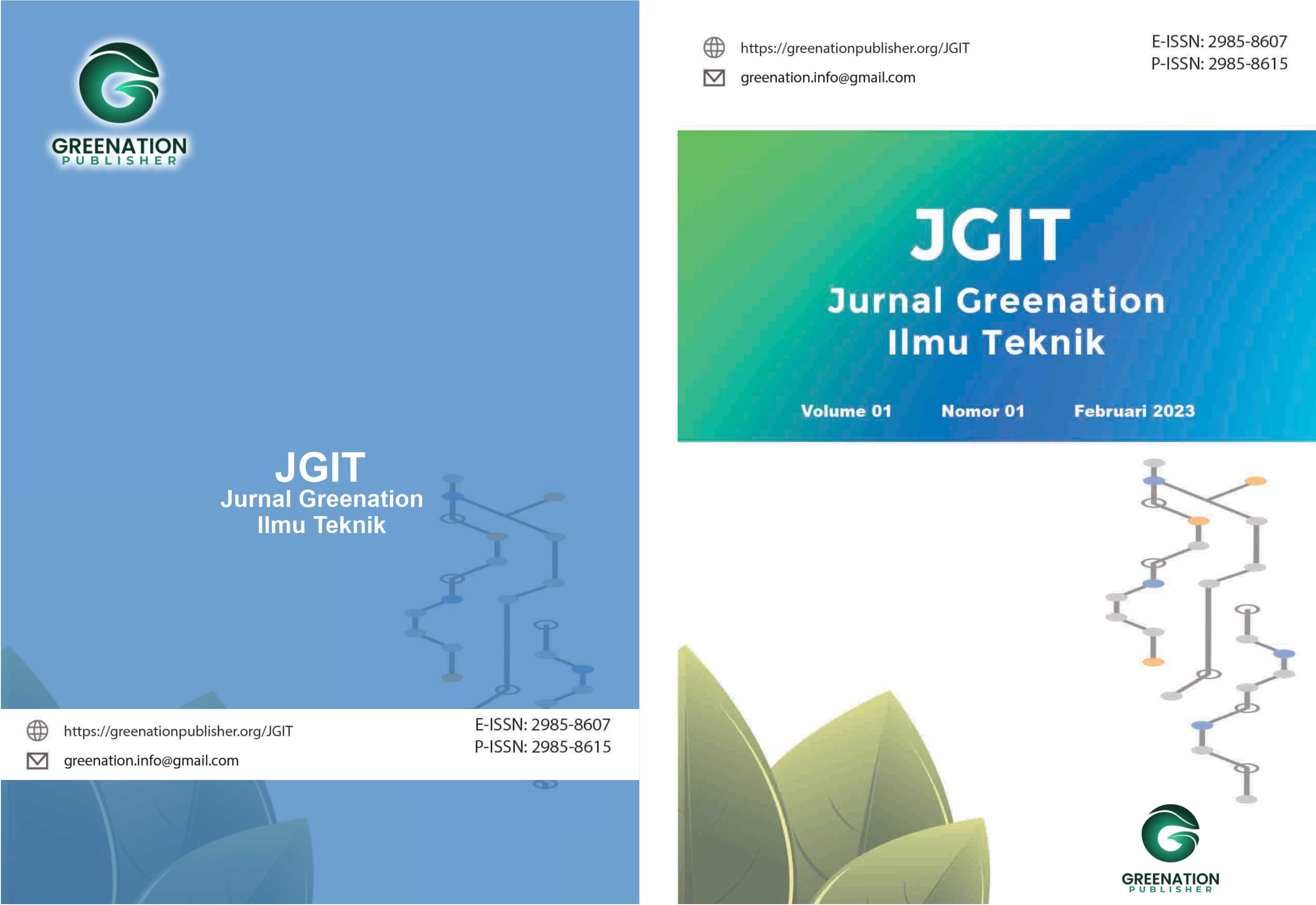Analisis Tingkat Risiko Banjir dan Tanah Longsor di Jalur Kereta Api Makassar-Parepare
DOI:
https://doi.org/10.38035/jgit.v2i3.74Keywords:
Analisis, banjir, kereta api, longsor, pemetaanAbstract
Transportasi umum merupakan kebutuhan utama bagi masyarakat di kota-kota dan kabupaten besar di Sulawesi Selatan, seperti Kota Makassar, Kabupaten Maros, Kabupaten Pangkajene dan Kepulauan, Kabupaten Barru, serta Kota Parepare. Kelancaran operasional kereta api Makassar-Parepare oleh PT Celebes Railway Indonesia menjadi prioritas utama dalam pengelolaan sistem transportasi massal. Beberapa kendala, seperti bencana banjir dan longsor, dapat mengancam operasional kereta api tersebut. Daerah yang berisiko mengalami banjir dan longsor di sepanjang jalur kereta api Makassar-Parepare dapat diidentifikasi melalui analisis Sistem Informasi Geografis. Penelitian ini bertujuan untuk menganalisis tingkat risiko banjir dan tanah longsor di sepanjang jalur operasional kereta api Makassar-Parepare dengan menggunakan metode scoring dan overlay yang terintegrasi dengan Sistem Informasi Geografis (SIG) menggunakan parameter yang berpengaruh terhadap banjir dan longsor meliputi kemiringan lahan, ketinggian lahan, curah hujan, jenis tanah, geologi, dan tekstur tanah. Hasil penelitian ini menunjukkan bahwa di sepanjang jalur kereta api Makassar-Parepare, terdapat area seluas 4459,445 Ha yang masuk pada kelas banjir risiko tinggi, 93555,26 Ha kelas banjir risiko sedang, 28538,32 Ha kelas banjir risiko rendah dan 37190,67 Ha termasuk kelas banjir aman. Jalur kereta api dari Stasiun Parangloe (13+900) hingga Stasiun Palanro (115+800) melalui daerah dengan kelas banjir “Risiko tinggi” dan “Risiko sedang”. Sementara itu, terdapat area seluas 13880,72 Ha yang masuk pada kelas longsor risiko tinggi, 69296,58 Ha kelas longsor risiko sedang, 54344,16 Ha kelas longsor risiko rendah, dan 26222,07 Ha termasuk kelas longsor aman. Jalur kereta api dari Stasiun Parangloe (13+900) hingga Stasiun Mandalle (67+857) melalui daerah dengan kelas longsor “Aman” dan “Risiko rendah”. Jalur kereta api dari Stasiun Mandalle (67+857) hingga Stasiun Palanro (115+800) melalui daerah dengan kelas longsor “Risiko sedang” dan “Risiko tinggi”.
References
Abuzeid TS, Ashour MA, Mahmoud H. 2022. Documenting and analyzing the harmful impacts of the seasonal floods in upper egypt on qena-safaga railway track infrastructure. JES. Journal of Engineering Sciences. 50(6): 292–311. https://doi.org/10.21608/jesaun.2022.140354.1139
Agusman R, Hanca Hayana N, Stiano DD. 2023. Pemanfaatan sistem informasi geografis (sig) untuk pemetaan tingkat rawan longsor menggunakan metode skoring dan overlay di kabupaten serang, banten. Jurnal Sains Geografi. 1(2): 1–11. https://doi.org/10.2210/jsg.vx1ix.xxx
Ahmad A, Farida M, Juita N. 2022. Analisis spasial tekstur tanah terhadap penilaian risiko bencana hidrometeorologi di kecamatan rumbia-kelara, kabupaten jeneponto. Jurnal Wilayah Dan Lingkungan. 10(1): 42–54. https://doi.org/10.14710/jwl.10.1.42-54
Anggara RB, Dwi M, Manessa M, Setiadi H. 2024. Pemetaan tingkat bahaya erosi di desa ciputri. Media Komunikasi Geografi. 25(1): 167–179.
Badwi, N., Baharuddin, I. I., & Abbas, I. (2020). Flood Hazard Level Mapping in Maros River Basin. La Geografia, 18(3), 309–322.
Baillie, P., & Decker, J. (2022). Enigmatic Sulawesi: The Tectonic Collage. Berita Sedimentologi, 48(1), 1–30. https://doi.org/10.51835/bsed.2022.48.1.388
Bandurin, ?. ?., Volosukhin, V. A., Prikhodko, I. A., & Rudenko, ?. ?. (2023). Analysis of the Stability of the Kuban River Landslide Slope Involving the Materials Of Landslide Hazard Monitoring. Construction and Geotechnics, 14(4), 62–74. https://doi.org/10.15593/2224-9826/2023.4.05
Biomantara, K., & Herdiansyah, H. (2019). Peran Kereta Api Indonesia (KAI) sebagai Infrastruktur Transportasi Wilayah Perkotaan. Cakrawala, 19(1), 1–8. http://ejournal.bsi.ac.id/ejurnal/index.php/cakrawala
Blum, W., Schad, P., & Stephen, N. (2018). Essentials of Soil Science. Borntraeger Science Publishers.
Chanieabate, M., He, H., Guo, C., Abrahamgeremew, B., & Huang, Y. (2023). Examining the Relationship between Transportation Infrastructure, Urbanization Level and Rural-Urban Income Gap in China. Sustainability, 15(10), 1?20. https://doi.org/10.3390/su15108410
Chaudhary, M. T., & Piracha, A. (2021). Natural Disasters—Origins, Impacts, Management. Encyclopedia, 1(4), 1101–1131. https://doi.org/10.3390/encyclopedia1040084
Chen, Z., & Li, X. (2021). Economic Impact of Transportation Infrastructure Investment under the Belt and Road Initiative. Asia Europe Journal, 19(1), 131–159. https://doi.org/10.1007/s10308-021-00617-3
Dang, T. A. (2022). Establishment of Flood Hazard Mapping based on Simulating Rainfall Intensity-Duration-Frequency Curve for the Ca Mau Peninsula of Vietnam. Mausam, 73(2), 355–364. https://doi.org/10.54302/mausam.v73i2.5481
Dhungana, G., Ghimire, R., Poudel, R., & Kumal, S. (2023). Landslide Susceptibility and Risk Analysis in Benighat Rural Municipality, Dhading, Nepal. Natural Hazards Research, 3(2), 170–185. https://doi.org/10.1016/j.nhres.2023.03.006
Fata, Y. A., Hendrayanto, Erizal, Tarigan, S. D., & Wibowo, C. (2022). Vetiver Root Cohesion at Different Growth Sites in Bogor, Indonesia. Biodiversitas, 23(3), 1683–1692. https://doi.org/10.13057/biodiv/d230360
Ferrante, C., Ciampoli, L. B., De Falco, M. C., D’Ascanio, L., Presta, D., & Schiattarella, E. (2020). Can A Fully Integrated Approach enclose the Drainage System Design and the flood Risk Analysis? Transportation Research Procedia, 45(2019), 811–818. https://doi.org/10.1016/j.trpro.2020.02.089
Fauzi A, Hadi, A. F. S. (2019). Kebijakan Pengelolaan Ruang dan Keberlanjutan Kawasan Karst Maros Pangkep Provinsi Sulawesi Selatan. Journal of Agriculture, Resource and Environmental Economics, 2(1), 26–37. https://doi.org/10.29244/jaree.v2i1.25934
Han, Y., Wang, P., Zheng, Y., Yasir, M., Xu, C., Nazir, S., Hossain, M. S., Ullah, S., & Khan, S. (2022). Extraction of Landslide Information Based on Object-Oriented Approach and Cause Analysis in Shuicheng, China. Remote Sensing, 14(3), 502. https://doi.org/10.3390/rs14030502
Hristov, B. (2020). The Soils of Botevgrad Valley. Ecological Engineering and Environment Protection, September, 20(2), 52–62. https://doi.org/10.32006/eeep.2020.2.5262
Irène, S., Simon, B., Jean-Claude, D. M., & M’baïti, N. (2022). Study of a Toposequence of West Mayo-Kani Soils (Far North Cameroon). Open Journal of Soil Science, 12(10), 523–539. https://doi.org/10.4236/ojss.2022.1210022
Karymbalis, E., Andreou, M., Batzakis, D. V., Tsanakas, K., & Karalis, S. (2021). Integration of GIS-based Multicriteria Decision Analysis and Analytic Hierarchy Process for Flood-Hazard Assessment in the Megalo Rema River Catchment (East Attica, Greece). Sustainability (Switzerland), 13(18), 1?24. https://doi.org/10.3390/su131810232
Kumne, W., & Samanta, S. (2023). Geospatial Mapping of Inland Flood Susceptibility Based on Multi-Criteria Analysis – A Case Study in the Final Flow of Busu River Basin, Papua New Guinea. International Journal of Geoinformatics, 19(6), 31–48. https://doi.org/10.52939/ijg.v19i6.2693
Kusnama, & Mangga, A. S. (2007). Hubungan Lingkungan Pengendapan Formasi Malawa dan Keterdapatan Batubara di Daerah Soppeng, Sulawesi Selatan. Jsdg, 17(4), 218–232.
Merlyn, A. R. (2023). Analisis Pemilihan Moda Transportasi antara Kereta Api dan Bus Rute Makassar-Parepare Ditinjau dari Efektivitas dan Efisiensi [University of Bosowa]. https://repository.unibos.ac.id/xmlui/handle/123456789/7742
Notti, D., Cignetti, M., Godone, D., & Giordan, D. (2023). Semi-automatic Mapping of Shallow Landslides using Free Sentinel-2 Images and Google Earth Engine. Natural Hazards and Earth System Sciences, 23(7), 2625–2648. https://doi.org/10.5194/nhess-23-2625-2023
Octaviarini, I. S., Fathani, T. F., Hardiyatmo, H. C., Amalina, A. N., & Erzagian, E. (2023). The Mechanism of Rainfall-Induced Landslide Around Railway Tracks in Central Java Province, Indonesia. INERSIA Lnformasi Dan Ekspose Hasil Riset Teknik Sipil Dan Arsitektur, 19(2), 212–222. https://doi.org/10.21831/inersia.v19i2.66835
Ogato, G. S., Bantider, A., Abebe, K., & Geneletti, D. (2020). Geographic Information System (GIS)-Based Multicriteria Analysis of flooding Hazard and Risk in Ambo Town and its Watershed, West Shoa Zone, Oromia Regional State, Ethiopia. Journal of Hydrology: Regional Studies, 27(2019), 1?18. https://doi.org/10.1016/j.ejrh.2019.100659
Ozulu, G., Essien, G. P., & Akudo, E. O. (2021). Geological and Geospatial Mapping of Vulnerability Areas for Proper Flood Mitigation: Ganaja, Lokoja Metropolis, North-Central Nigeria. International Journal of Environment and Geoinformatics, 8(3), 267–275. https://doi.org/10.30897/ijegeo.828668
Peleg, N., Ban, N., Gibson, M. J., Chen, A. S., Paschalis, A., Burlando, P., & Leitão, J. P. (2022). Mapping Storm Spatial Profiles for Flood Impact Assessments. Advances in Water Resources, 166(June), 1-11. https://doi.org/10.1016/j.advwatres.2022.104258
Prabowo, D., & Rahman, R. A. P. (2023). Identifikasi Potensi Banjir Di Kawasan Sub Urban Kota Semarang (Studi Kasus Kab Kendal). Jurnal Planologi, 20(1), 1?16. https://doi.org/10.30659/jpsa.v20i1.28223
Pratama, T. P. E., Supardi, Prihadita, W. P., Yuliatama, V. P., Ramadhani, S. P., Safitri, W., & Syifa, H. N. (2020). Analisis Index Overlay Untuk Pemetaan Kawasan Berpotensi Banjir di Gowa, Provinsi Sulawesi Selatan. Jurnal Geosains Dan Remote Sensing, 1(1), 52–64. https://doi.org/10.23960/jgrs.2020.v1i1.26
Quesada Román, A. (2021). Landslides and Floods Zonation using geomorphological Analyses in a dynamic Basin of Costa Rica. Revista Cartográfica, 102(1), 125–138. https://doi.org/10.35424/rcarto.i102.901
Rakuasa. (2023). Pemetaan Daerah Rawan Banjir di Desa Batumerah Kecamatan Sirimau Kota Ambon Menggunakan Sistim Informasi Geografis. Jurnal Ilmiah Multidisiplin, 2(4), 1642–1653. https://journal-nusantara.com/index.php/JIM/article/view/1475
Ramesh, G. (2021). Slope and Landslide Stabilization: A Review. Indian Journal of Structure Engineering, 1(2), 13–16. https://doi.org/10.54105/ijse.a1304.111221
Roy, S., Debnath, P., & Mitra, S. (2023). Impact of Climate Disasters on Railway Infrastructure: Case Study of Northeast India. Acadlore Transactions on Geosciences, 2(1), 33–45. https://doi.org/10.56578/atg020104
Roy, S., & Mitra, S. (2019). Railway Stations of Tripura, India: An Assessment of Infrastructural Conditions. In Urbanization and Regional Sustainability in South Asia. Springer, Cham. https://doi.org/https://doi.org/10.1007/978-3-030-23796-7_11
Rusdiana, D. D., Nuryandini, R., Heni Imelia, J., & Syifa Hafidah, N. (2021). Pemanfaatan Informasi Spasial Berbasis SIG untuk Pemetaan Tingkat Kerawanan Longsor di Kabupaten Karangasem, Bali. Jurnal Geosains Dan Remote Sensing, 2(2), 49–55. https://doi.org/10.23960/jgrs.2021.v2i2.51
Sarma, V. A. K. (2012). Vertisols. In Major Soil Grous of the World. CRC Press. https://doi.org/10.2136/sh1971.1.0007
Sholikhan, M., Prasetyo, S. Y. J., & Hartomo, K. D. (2019). Pemanfaatan WebGIS untuk Pemetaan Wilayah Rawan Longsor Kabupaten Boyolali dengan Metode Skoring dan Pembobotan. Jurnal Teknik Informatika Dan Sistem Informasi, 5(1), 131–143. https://doi.org/10.28932/jutisi.v5i1.1588
Silalahi, F. E. S., Pamela, Arifianti, Y., & Hidayat, F. (2019). Landslide Susceptibility Assessment using Frequency Ratio Model in Bogor, West Java, Indonesia. Geoscience Letters, 6(1), 1?17. https://doi.org/10.1186/s40562-019-0140-4
Sitorus, I. H. O., Bioresita, F., & Hayati, N. (2021). Analisa Tingkat Rawan Banjir di Daerah Kabupaten Bandung Menggunakan Metode Pembobotan dan Scoring. Jurnal Teknik ITS, 10(1), 14?19. https://doi.org/10.12962/j23373539.v10i1.60082
Sumunar, D. R. S. (2020). Flood Vulnerability Mapping Using Geographic Information System (GIS) in Gajah Wong Sub Watershed Yogyakarta. Geosfera Indonesia, 5(1), 47–64
Syamsudin. (2011). Bab II Landasan Teori. Journal of Chemical Information and Modeling, 53(9), 1689–1699
Tamtomo Adi, W., Aghastya, A., Prihatanto, R., Rizky Cahyono, A., & Anwer, I. (2023). Landslide Susceptibility Assessment of a Railway Based on GIS Application. Journal of Railway Transportation and Technology, 2(2), 12–23. https://doi.org/10.37367/jrtt.v2i2.27
Ulfiana, A., Arsyad, M., & Palloan, P. (2023). The Atmospheric Dynamics Related to Extreme Rainfall and Flood Events during September-October-November in South Sulawesi. Forum Geografi, 37(2), 107–116. https://doi.org/10.23917/forgeo.v37i2.22339
Zhang, L., & Hua, X. (2023). Evaluating efficiency of railway transportation based on cross?efficiency evaluation method and relative entropy evaluation method in China. IET Intelligent Transport Systems, 17(12), 2410–2418. https://doi.org/10.1049/itr2.12420
Downloads
Published
How to Cite
Issue
Section
License
Copyright (c) 2024 Aura Putri Zafira, Sutoyo, Heriansyah Putra, Jatmiko Murdiono, Danang Arief Nugroho

This work is licensed under a Creative Commons Attribution 4.0 International License.
Hak cipta :
Penulis yang mempublikasikan manuskripnya di jurnal ini menyetujui ketentuan berikut:
- Hak cipta pada setiap artikel adalah milik penulis.
- Penulis mengakui bahwa Jurnal Greenation Ilmu Teknik (JGIT) berhak menjadi yang pertama menerbitkan dengan lisensi Creative Commons Attribution 4.0 International (Attribution 4.0 International CC BY 4.0) .
- Penulis dapat mengirimkan artikel secara terpisah, mengatur distribusi non-eksklusif manuskrip yang telah diterbitkan dalam jurnal ini ke versi lain (misalnya, dikirim ke repositori institusi penulis, publikasi ke dalam buku, dll.), dengan mengakui bahwa manuskrip telah diterbitkan pertama kali di JGIT.






















